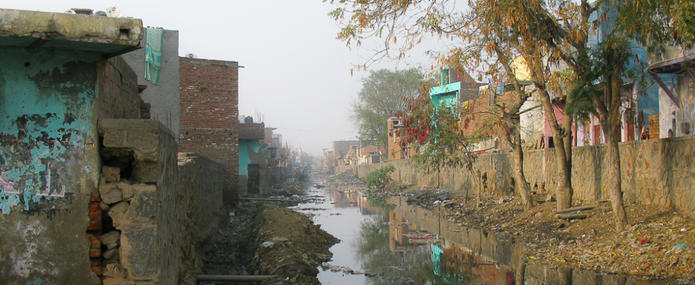In 2018, 4.5 billion people in the world (or 61% of the total population) have no access to safely managed sanitation services, including 2.5 billion people (30%) with no basic sanitary installations (toilets or latrines) and almost 1 billion practicing open defecation. This year, 2018, is also the year in which Sustainable Development Goal 6 on water and sanitation will be reviewed by the High-Level Political Forum to be held at the United Nations in July, 10 years after the United Nations International Year of Sanitation. Where are we in terms of progress and efforts in this sector? What role and importance does sanitation actually have in sustainable urban development?
Sanitation and sustainable urban development
In view of urban growth rates in Africa (3-5 %) and Asia (≈3 %), two continents where the lack of sanitation is the most striking, the issue of urban sanitation is crucial. Not only is it a “time bomb” for health in the dense, congested cities, but the cost of inaction is also growing exponentially. The sense of urgency is compounded by the fact that the benefits provided by improving access to sanitation can have repercussions on all dimensions of sustainable urban development.
- On a social level, the control of epidemies and public health are quickly improved. On the individual level, access to toilets immediately improves living conditions: comfort, hygiene and human dignity are all increased, more specifically for women who have better privacy and safety. Furthermore, actions in this sector help to improve working conditions – which are often unhealthy or even dangerous – for sanitation operators, who are typically precarious, informal workers.
- According to the World Health Organization (WHO), the cost of poor sanitation amounts to 7% of GDP in low-income countries, due to the decline in worker productivity and the lower economic appeal of cities with inadequate sanitation. On the contrary, the WHO estimates that the return on sanitation spending is 5.5 US dollars for every 1 dollar invested. In other words, while the benefits of sanitation may sometimes seem intangible, they are in fact very real.
- Better urban sanitation unquestionably contributes to environmental protection, through a reduction in pollution of soils, waterways and groundwater. It also helps to mitigate the adverse impacts of flooding exacerbated by climate change.
Finally, in developing cities, sanitation is a fundamentally urban challenge. Public health is directly impacted by the quality of sanitation. Interactions with the urban environment and other services also make it a key sector: interdependencies with the solid waste, water, and even agricultural sectors in the context of the circular economy through waste water reuse.
Taking measures to improve sanitation system access and functioning in cities is therefore instrumental to sustainable urban development. Nevertheless, despite this potential, sanitation is still sidelined in basic services, especially in relation to access to drinking water, for example.
International advocacy, innovation and political will
However, since the 1990s, an international community of expertise has been supporting these arguments. Based on the concept of “ecological sanitation” (ecosan), international principles and declarations have been established, and a target aimed at halving the percentage of people without access to clean water and basic sanitation services was added to the Sustainable Development Goals (2000-2015); although good progress has been made for water, the same cannot be said for sanitation. In 2007, the Sustainable Sanitation Alliance exchange platform was created and the United Nations made 2008 the International Year of Sanitation.
But progress is still needed. Over the last few years, the issue has re-emerged: the adoption of a specific target in the SDGs, the commitment of the Bill & Melinda Gates Foundation, the success of the international Faecal Sludge Management Conferences (FSM), the creation of the Toilet Board Coalition, etc., all contribute to greater visibility. In 2017, the World Bank launched the Citywide Inclusive Sanitation appeal, capitalising on this movement.
At the same time, numerous NGOs and research institutes are conducting pioneering projects aimed at demonstrating the feasibility of technical and commercial solutions for sanitation. Based on the principle that conventional sewer systems are neither viable (too costly, unsuited to the dense and irregular built environment), nor necessarily desirable or sustainable (insufficient resilience to extreme climate events, overconsumption of water resources), actors in the field are promoting alternative or hybrid sanitation systems: dry or self-contained toilets, community participation techniques, sanitary equipment markets with commercial offers for the poorest, or capacity building initiatives for pit emptiers and decision support tools for the authorities (concerted municipal strategies, Mémento de l’assainissement - sanitation memento). There is no shortage of tried and tested ideas, but the challenge is scaling up.
Unfortunately, sanitation still receives little in the way of political and financial resources and attention. Since it is unappealing on a symbolic and cultural level, sanitation raises few explicit demands from local populations and policymakers. Moreover, alternatives involving decentralised systems depart from the Western sewer model, which still serves as a reference. Consequently, the methods of intervention adopted by donors and international urban service operators, traditionally based on financing large infrastructures and unsuited to supporting the myriad small local operators with varied technical and commercial solutions, also need to be revised. Under these conditions, moving away from business-as-usual, innovating and working with stigmatised techniques and actors is a dual challenge: it implies both stimulating local political will to address a taboo subject and inventing new multi-stakeholder governance models and arrangements to ensure sanitation reaches its potential in terms of contributing to sustainable urban development, especially for the most vulnerable people.
Issue Brief July 2018 Read also Sanitation in developing cities: from politics to policies

